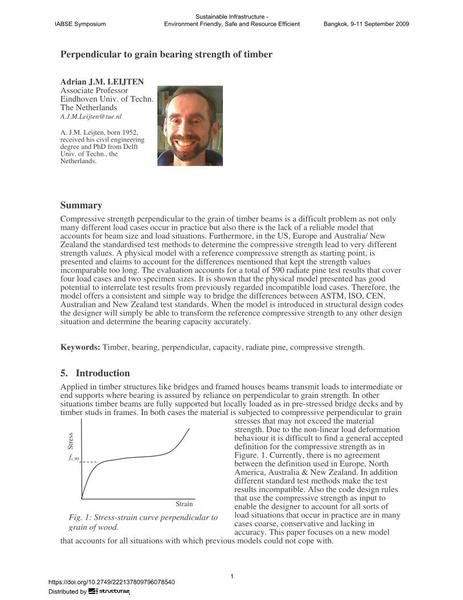Perpendicular to grain bearing strength of timber

|
|
|||||||||||
Détails bibliographiques
| Auteur(s): |
Ad J. M. Leijten
|
||||
|---|---|---|---|---|---|
| Médium: | papier de conférence | ||||
| Langue(s): | anglais | ||||
| Conférence: | IABSE Symposium: Sustainable Infrastructure - Environment Friendly, Safe and Resource Efficient, Bangkok, Thailand, 9-11 September 2009 | ||||
| Publié dans: | IABSE Symposium Bangkok 2009 | ||||
|
|||||
| Page(s): | 145-153 | ||||
| Nombre total de pages (du PDF): | 7 | ||||
| Année: | 2009 | ||||
| DOI: | 10.2749/222137809796078540 | ||||
| Abstrait: |
Compressive strength perpendicular to the grain of timber beams is a difficult problem as not only many different load cases occur in practice but also there is the lack of a reliable model that accounts for beam size and load situations. Furthermore, in the US, Europe and Australia/ New Zealand the standardised test methods to determine the compressive strength lead to very different strength values. A physical model with a reference compressive strength as starting point, is presented and claims to account for the differences mentioned that kept the strength values incomparable too long. The evaluation accounts for a total of 590 radiate pine test results that cover four load cases and two specimen sizes. It is shown that the physical model presented has good potential to interrelate test results from previously regarded incompatible load cases. Therefore, the model offers a consistent and simple way to bridge the differences between ASTM, ISO, CEN, Australian and New Zealand test standards. When the model is introduced in structural design codes the designer will simply be able to transform the reference compressive strength to any other design situation and determine the bearing capacity accurately. |
||||
| Mots-clé: |
Appuis de pont
|
||||
